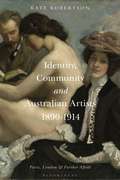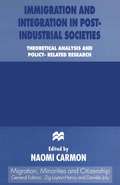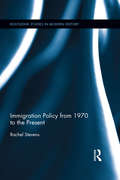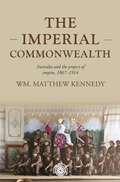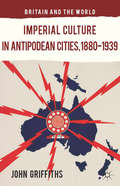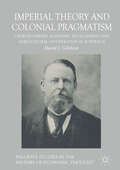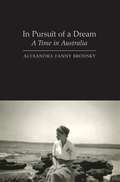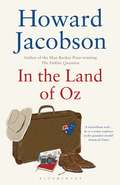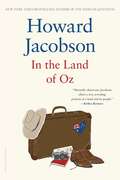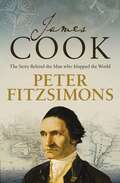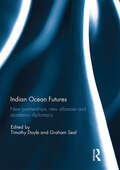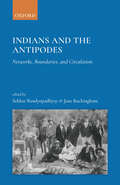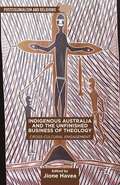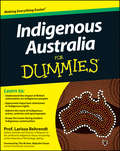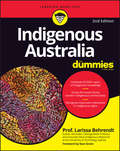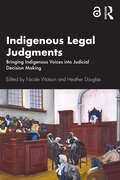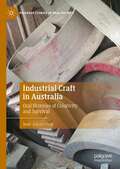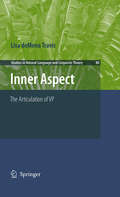- Table View
- List View
Identity, Community & Australian Artists, 1890-1914: Paris, London and Further Afield
by Kate R. RobertsonAn irresistible call lured Australian artists abroad between 1890 and 1914, a transitional period immediately pre- and post-federation. Travelling enabled an extension of artistic frontiers, and Paris – the centre of art – and London – the heart of the Empire – promised wondrous opportunities. These expatriate artists formed communities based on their common bond to Australia, enacting their Australian-ness in private and public settings. Yet, they also interacted with the broader creative community, fashioning a network of social and professional relationships. They joined ateliers in Paris such as the Académie Julian, clubs like the Chelsea Arts Club in London and visited artist colonies including St Ives in England and Étaples in France. Australian artists persistently sought a sense of belonging, negotiating their identity through activities such as plays, balls, tableaux, parties, dressing-up and, of course, the creation of art. While individual biographies are integral to this study, it is through exploring the connections between them that it offers new insights. Through utilising extensive archival material, much of which has limited or no publication history, this book fills a gap in existing scholarship. It offers a vital exploration re-consideration of the fluidity of identity, place and belonging in the lives and work of Australian artists in this juncture in British-Australian history.
Identity, Community & Australian Artists, 1890-1914: Paris, London and Further Afield (Criminal Practice Ser.)
by Kate R. RobertsonAn irresistible call lured Australian artists abroad between 1890 and 1914, a transitional period immediately pre- and post-federation. Travelling enabled an extension of artistic frontiers, and Paris – the centre of art – and London – the heart of the Empire – promised wondrous opportunities. These expatriate artists formed communities based on their common bond to Australia, enacting their Australian-ness in private and public settings. Yet, they also interacted with the broader creative community, fashioning a network of social and professional relationships. They joined ateliers in Paris such as the Académie Julian, clubs like the Chelsea Arts Club in London and visited artist colonies including St Ives in England and Étaples in France. Australian artists persistently sought a sense of belonging, negotiating their identity through activities such as plays, balls, tableaux, parties, dressing-up and, of course, the creation of art. While individual biographies are integral to this study, it is through exploring the connections between them that it offers new insights. Through utilising extensive archival material, much of which has limited or no publication history, this book fills a gap in existing scholarship. It offers a vital exploration re-consideration of the fluidity of identity, place and belonging in the lives and work of Australian artists in this juncture in British-Australian history.
Immigration and Integration in Post-Industrial Societies: Theoretical Analysis and Policy-Related Research (Migration, Diasporas and Citizenship)
by Naomi CarmonNaomi Carmon has brought together a group of distinguished scholars from post-industrial countries to discuss changes in immigration flows, their impact on the receiving countries, and alternative policy responses. Experts in sociology, economics, political science, geography and urban planning base their analyses on evidence from USA, Australia, Britain, France and Israel. They examine past experience and analyze the present situation, in which new types of immigrants, in changing circumstances, are creating new patterns of settlement and integration.
Immigration Policy from 1970 to the Present (Routledge Studies in Modern History)
by Rachel StevensThis book examines national debates on immigration, asylum seekers and guest worker programs from 1970 to the present. Over the past 45 years, contemporary immigration has had a profound impact throughout North America, Europe and Australasia, yet the admission of ethnically diverse immigrants was far from inevitable. In the midst of significant social change, policymakers grappled with fundamental questions: what is the purpose of immigration in an age of mass mobility? Which immigrants should be selected and potentially become citizens and who should be excluded? How should immigration be controlled in an era of universal human rights and non-discrimination? Stevens provides an in-depth case study comparison of two settler societies, Australia and the United States, while drawing parallels with Europe, Canada and New Zealand. Though contemporary immigration history that focuses on one national setting is well established, this book is unique because it actively compares how a number of societies debated vexing immigration policy challenges. The book also explores the ideas, values and principles that underpin this contentious area of public policy, and in doing so permits a broader understanding of contemporary immigration than outlining policies alone.
Immigration Policy from 1970 to the Present (Routledge Studies in Modern History #19)
by Rachel StevensThis book examines national debates on immigration, asylum seekers and guest worker programs from 1970 to the present. Over the past 45 years, contemporary immigration has had a profound impact throughout North America, Europe and Australasia, yet the admission of ethnically diverse immigrants was far from inevitable. In the midst of significant social change, policymakers grappled with fundamental questions: what is the purpose of immigration in an age of mass mobility? Which immigrants should be selected and potentially become citizens and who should be excluded? How should immigration be controlled in an era of universal human rights and non-discrimination? Stevens provides an in-depth case study comparison of two settler societies, Australia and the United States, while drawing parallels with Europe, Canada and New Zealand. Though contemporary immigration history that focuses on one national setting is well established, this book is unique because it actively compares how a number of societies debated vexing immigration policy challenges. The book also explores the ideas, values and principles that underpin this contentious area of public policy, and in doing so permits a broader understanding of contemporary immigration than outlining policies alone.
The imperial Commonwealth: Australia and the project of empire, 1867-1914 (Studies in Imperialism #202)
by Wm. Matthew KennedyFrom the late 1800s to the early 1900s, Australian settler colonists mobilised their unique settler experiences to develop their own vision of what ‘empire’ was and could be. Reinterpreting their histories and attempting to divine their futures with a much heavier concentration on racialized visions of humanity, white Australian settlers came to believe that their whiteness as well as their Britishness qualified them for an equal voice in the running of Britain’s imperial project. Through asserting their case, many soon claimed that, as newly minted citizens of a progressive and exemplary Australian Commonwealth, white settlers such as themselves were actually better suited to the modern task of empire. Such a settler political cosmology with empire at its center ultimately led Australians to claim an empire of their own in the Pacific Islands, complete with its own, unique imperial governmentality.
The imperial Commonwealth: Australia and the project of empire, 1867-1914 (Studies in Imperialism #202)
by Wm. Matthew KennedyFrom the late 1800s to the early 1900s, Australian settler colonists mobilised their unique settler experiences to develop their own vision of what ‘empire’ was and could be. Reinterpreting their histories and attempting to divine their futures with a much heavier concentration on racialized visions of humanity, white Australian settlers came to believe that their whiteness as well as their Britishness qualified them for an equal voice in the running of Britain’s imperial project. Through asserting their case, many soon claimed that, as newly minted citizens of a progressive and exemplary Australian Commonwealth, white settlers such as themselves were actually better suited to the modern task of empire. Such a settler political cosmology with empire at its center ultimately led Australians to claim an empire of their own in the Pacific Islands, complete with its own, unique imperial governmentality.
Imperial Culture in Antipodean Cities, 1880-1939 (Britain and the World)
by J. GriffithsDrawing on a wealth of primary and secondary sources, this book explores how far imperial culture penetrated antipodean city institutions. It argues that far from imperial saturation, the city 'Down Under' was remarkably untouched by the Empire.
Imperial Theory and Colonial Pragmatism: Charles Harper, Economic Development and Agricultural Co-operation in Australia (Palgrave Studies in the History of Economic Thought)
by David J. GilchristThis book considers the role played by co-operative agriculture as a critical economic model which, in Australia, helped build public capital, drive economic development and impact political arrangements. In the case of colonial Western Australia, the story of agricultural co-operation is inseparable from that of the story of Charles Harper. Harper was a self-starting, pioneering frontiersman who became a political, commercial and agricultural leader in the British Empire’s most isolated colony during the second half of the Victorian era. He was convinced of the successful economic future of Western Australia but also pragmatic enough to appreciate that the unique challenges facing the colony were only going to be resolved by the application of unorthodox thinking. Using Harper’s life as a foil, this book examines Imperial economic thinking in relation to the co-operative form of economic organisation, the development of public capital, and socialism. It uses this discussion to demonstrate the transfer of socialistic ideas from the centre of the Empire to the farthest reaches of the Antipodes where they were used to provide a rhetorical crutch in support of purely pragmatic co-operative establishments.
In Pursuit of a Dream: A Time in Australia
by Alexandra Fanny BrodskyA vibrant and moving memoir of life in Australia and Europe in the middle of the twentieth century.In Pursuit of a Dream begins with a brief portrait of the author's family circumstances after the Second World War, when they were finally reunited after being forced into hiding to escape the Gestapo. This appealing personal history combines autobiography with a picture of the international situation in the middle of the twentieth century. After some time spent visiting friends and family in war-torn France and Belgium, the author and her parents obtained passes to join her brother in Australia on a journey which was to change her life completely. Through her eyes we experience the sea voyage and Sydney life in the 1940s and gain an original perspective on Australia during this period. Her vivid descriptions clearly convey the impact of post-war migration, and the story of her subsequent return to Europe and later marriage to the Australian scientist, Henry Harris, make this a most attractive and authentic cultural history.
In the Land of Oz
by Howard JacobsonOn what he calls 'the adventure of his life', Howard Jacobson travels around Australia, never entirely sure where he is heading next or whether he has the courage to tackle the wild life of the bush, the wild men of the outback, or the even wilder women of the seaboard cities. In pursuit of the best of Australian good times, he joins revelers at Uluru, argues with racists in the Kimberleys, parties with wine-growers in the Barossa and falls for ballet dancers in Perth. And even as vexed questions of national identity and Aboriginal land rights present themselves, his love for Australia and Australians never falters.
In the Land of Oz
by Howard JacobsonThe Man Booker Prize-winning author of The Finkler Question went Down Under, and this is what he hilariously found. On what he calls “the adventure of his life,” Howard Jacobson travels around Australia, never entirely sure where he is heading next or whether he has the courage to tackle the wild life of the bush, the wild men of the outback, or the even wilder women of the seaboard cities. In pursuit of the best of Australian good times, he joins revelers at Uluru, argues with racists in the Kimberleys, parties with winegrowers in the Barossa, and falls for ballet dancers in Perth. And even as vexed questions of national identity and Aboriginal land rights present themselves, his love for Australia and Australians never falters.
The Incredible Life of Hubert Wilkins: Australia's Greatest Explorer
by Peter FitzSimonsCaptain James Cook is one of the most recognisable in Australian history - an almost mythic figure who is often discussed, celebrated, reviled and debated. But who was the real James Cook?The name Captain James Cook is one of the most recognisable in Australian history - an almost mythic figure who is often discussed, celebrated, reviled and debated.But who was the real James Cook?This Yorkshire farm boy would go on to become the foremost mariner, navigator and cartographer of his era, and to personally map a third of the globe. His great voyages of discovery were incredible feats of seamanship and navigation. Leading a crew of men into uncharted territories, Cook would face the best and worst of humanity as he took himself and his crew to the edge of the known world - and beyond.With his masterful storytelling talent, Peter FitzSimons brings James Cook to life. Focusing on his most iconic expedition, the voyage of the Endeavour, where Cook first set foot on Australian and New Zealand soil, FitzSimons contrasts Cook against another figure who looms large in Australasian history: Joseph Banks, the aristocratic botanist. As they left England, Banks, a rich, famous playboy, was everything that Cook was not. The voyage tested Cook's character and would help define his legacy.Now, 240 years after James Cook's death, FitzSimons reveals what kind of man James was at heart. His strengths, his weaknesses, his passions and pursuits, failures and successes.JAMES COOK reveals the man behind the myth.
Indian Ocean Futures: New Partnerships, New Alliances, and Academic Diplomacy
by Timothy Doyle Graham SealIndian Ocean studies, which once lagged behind studies of the Atlantic and the Pacific, is an important emerging academic field which has come into its own. In the next fifty years, the Indian Ocean Region will become very significant as a result of enormous demographic changes. What was the Ocean of the South is rapidly becoming the Ocean of the Centre, the Ocean of the Future. Curtin University, Western Australia, has a long and distinguished history of engagement with the Indian Ocean region and with Indian Ocean Studies, and its Australia-Asia-Pacific Institute of Curtin University continues to maintain a focus on the Indian Ocean -past, present and future. This book examines a number of themes emerging from its 2014 Conference entitled "Indian Ocean Futures", which attracted some of the best Indian Ocean region scholars. The conference connected humanities, social sciences and scientific disciplines; this book collects some of the preeminent works focused on geo-strategic, cultural, environmental security and human security themes. The book is also an important contribution to the building of academic diplomacy in the region – that is to say, it contributes to region-building by creating epistemic communities and networks between government, the private sector, and academia throughout the region. Through the pursuit of academic diplomacy, academics are capable of pursuing research goals which enhance governmental, business, and civil society objectives of the day. This book was previously published as a special issue of the Journal of the Indian Ocean Region.
Indian Ocean Futures: New Partnerships, New Alliances, and Academic Diplomacy
by Timothy Doyle Graham SealIndian Ocean studies, which once lagged behind studies of the Atlantic and the Pacific, is an important emerging academic field which has come into its own. In the next fifty years, the Indian Ocean Region will become very significant as a result of enormous demographic changes. What was the Ocean of the South is rapidly becoming the Ocean of the Centre, the Ocean of the Future. Curtin University, Western Australia, has a long and distinguished history of engagement with the Indian Ocean region and with Indian Ocean Studies, and its Australia-Asia-Pacific Institute of Curtin University continues to maintain a focus on the Indian Ocean -past, present and future. This book examines a number of themes emerging from its 2014 Conference entitled "Indian Ocean Futures", which attracted some of the best Indian Ocean region scholars. The conference connected humanities, social sciences and scientific disciplines; this book collects some of the preeminent works focused on geo-strategic, cultural, environmental security and human security themes. The book is also an important contribution to the building of academic diplomacy in the region – that is to say, it contributes to region-building by creating epistemic communities and networks between government, the private sector, and academia throughout the region. Through the pursuit of academic diplomacy, academics are capable of pursuing research goals which enhance governmental, business, and civil society objectives of the day. This book was previously published as a special issue of the Journal of the Indian Ocean Region.
Indians and the Antipodes: Networks, Boundaries, and Circulation
by Sekhar Bandyopadhyay Jane BuckinghamThe Indian diaspora in Australia and New Zealand represents a successful ethnic community making significant contributions to their host societies and economies. However, because of their small number—slightly more than half a million— they rarely find mention in the global literature on Indian diaspora. The present volume seeks to remedy this oversight. Charting the chequered 250-year-old history of both the ‘old’ and the ‘new’ diaspora in the antipodes, the chapters narrate the stories of labourers who journeyed under the pressure of colonial capital and post-war professional migrants who went in search of better opportunities. In the context of the ‘White Australia’ and ‘White New Zealand’ policies designed to stem the arrival of Asians in the early twentieth century, we read of the complex survival stratagems adopted by migrants to circumvent the stringent insular world view of the existing white settlers in these countries. Together with stories of the collective suffering and struggles of the diaspora, we are presented with stories of individual resilience, enterprise, and social mobility.
Indigenous Australia and the Unfinished Business of Theology: Cross-Cultural Engagement (Postcolonialism and Religions)
by Jione HaveaThis book engages a complex subject that mainline theologies avoid, Indigenous Australia. The heritages, wisdoms and dreams of Indigenous Australians are tormented by the discriminating mindsets and colonialist practices of non-Indigenous peoples. This book gives special attention to the torments due to the arrival and development of the church.
Indigenous Australia for Dummies (For Dummies Ser.)
by Larissa BehrendtA comprehensive, relevant, and accessible look at all aspects of Indigenous Australian history and culture What is The Dreaming? How many different Indigenous tribes and languages once existed in Australia? What is the purpose of a corroboree? What effect do the events of the past have on Indigenous peoples today? Indigenous Australia For Dummies answers these questions and countless others about the oldest race on Earth. It explores Indigenous life in Australia before 1770, the impact of white settlement, the ongoing struggle by Aboriginal and Torres Strait Islander peoples to secure their human rights and equal treatment under the law, and much more. Celebrating the contributions of Indigenous people to contemporary Australian culture, the book explores Indigenous art, music, dance, literature, film, sport, and spirituality. It discusses the concept of modern Indigenous identity and examines the ongoing challenges facing Indigenous communities today, from health and housing to employment and education, land rights, and self-determination. Explores significant political moments—such as Paul Keating's Redfern Speech and Kevin Rudd's apology, and more Profiles celebrated people and organisations in a variety of fields, from Cathy Freeman to Albert Namatjira to the Bangarra Dance Theatre and the National Aboriginal Radio Service Challenges common stereotypes about Indigenous people and discusses current debates, such as a land rights and inequalities in health and education This book will enlighten readers of all backgrounds about the history, struggles and triumphs of the diverse, proud, and fascinating peoples that make up Australia's Indigenous communities. With a foreword by former PM Malcolm Fraser, Indigenous Australia For Dummies is a must-read account of Australia's first people. 'Indigenous Australia For Dummies is an important contribution to the broad debate and to a better understanding of our past history. Hopefully it will influence future events.'—Former Prime Minister Malcolm Fraser
Indigenous Australia for Dummies
by Larissa BehrendtA comprehensive, relevant, and accessible look at all aspects of Indigenous Australian history and culture What is The Dreaming? How many different Indigenous tribes and languages once existed in Australia? What is the purpose of a corroboree? What effect do the events of the past have on Indigenous peoples today? Indigenous Australia For Dummies answers these questions and countless others about the oldest race on Earth. It explores Indigenous life in Australia before 1770, the impact of white settlement, the ongoing struggle by Aboriginal and Torres Strait Islander peoples to secure their human rights and equal treatment under the law, and much more. Celebrating the contributions of Indigenous people to contemporary Australian culture, the book explores Indigenous art, music, dance, literature, film, sport, and spirituality. It discusses the concept of modern Indigenous identity and examines the ongoing challenges facing Indigenous communities today, from health and housing to employment and education, land rights, and self-determination. Explores significant political moments—such as Paul Keating's Redfern Speech and Kevin Rudd's apology, and more Profiles celebrated people and organisations in a variety of fields, from Cathy Freeman to Albert Namatjira to the Bangarra Dance Theatre and the National Aboriginal Radio Service Challenges common stereotypes about Indigenous people and discusses current debates, such as a land rights and inequalities in health and education This book will enlighten readers of all backgrounds about the history, struggles and triumphs of the diverse, proud, and fascinating peoples that make up Australia's Indigenous communities. With a foreword by former PM Malcolm Fraser, Indigenous Australia For Dummies is a must-read account of Australia's first people. 'Indigenous Australia For Dummies is an important contribution to the broad debate and to a better understanding of our past history. Hopefully it will influence future events.'—Former Prime Minister Malcolm Fraser
Indigenous Australia For Dummies
by Larissa BehrendtA comprehensive, relevant, and accessible look at all aspects of Indigenous Australian history and culture What is The Dreaming? How many different Indigenous tribes and languages once existed in Australia? What is the purpose of a corroboree? What effect do the events of the past have on Indigenous peoples today? Indigenous Australia For Dummies, Second Edition answers these questions and countless others about the oldest race on Earth. It explores Indigenous life in Australia before 1770, the impact of white settlement, the ongoing struggle by Aboriginal and Torres Strait Islander peoples to secure their human rights and equal treatment under the law, and much more. Celebrating the contributions of Indigenous people to contemporary Australian culture, the book explores Indigenous art, music, dance, literature, film, sport, and spirituality. It discusses the concept of modern Indigenous identity and examines the ongoing challenges facing Indigenous communities today, from health and housing to employment and education, land rights, and self-determination. Explores significant political moments—such as Paul Keating's Redfern Speech and Kevin Rudd's apology, and more Profiles celebrated people and organisations in a variety of fields, from Cathy Freeman to Albert Namatjira to the Bangarra Dance Theatre and the National Aboriginal Radio Service Challenges common stereotypes about Indigenous people and discusses current debates, such as a land rights and inequalities in health and education Now in its second edition, this book will enlighten readers of all backgrounds about the history, struggles and triumphs of the diverse, proud, and fascinating peoples that make up Australia's Indigenous communities. With a foreword by Stan Grant, Indigenous Australia For Dummies, Second Edition is a must-read account of Australia’s first people.
Indigenous Australia For Dummies (For Dummies Ser.)
by Larissa BehrendtA comprehensive, relevant, and accessible look at all aspects of Indigenous Australian history and culture What is The Dreaming? How many different Indigenous tribes and languages once existed in Australia? What is the purpose of a corroboree? What effect do the events of the past have on Indigenous peoples today? Indigenous Australia For Dummies, Second Edition answers these questions and countless others about the oldest race on Earth. It explores Indigenous life in Australia before 1770, the impact of white settlement, the ongoing struggle by Aboriginal and Torres Strait Islander peoples to secure their human rights and equal treatment under the law, and much more. Celebrating the contributions of Indigenous people to contemporary Australian culture, the book explores Indigenous art, music, dance, literature, film, sport, and spirituality. It discusses the concept of modern Indigenous identity and examines the ongoing challenges facing Indigenous communities today, from health and housing to employment and education, land rights, and self-determination. Explores significant political moments—such as Paul Keating's Redfern Speech and Kevin Rudd's apology, and more Profiles celebrated people and organisations in a variety of fields, from Cathy Freeman to Albert Namatjira to the Bangarra Dance Theatre and the National Aboriginal Radio Service Challenges common stereotypes about Indigenous people and discusses current debates, such as a land rights and inequalities in health and education Now in its second edition, this book will enlighten readers of all backgrounds about the history, struggles and triumphs of the diverse, proud, and fascinating peoples that make up Australia's Indigenous communities. With a foreword by Stan Grant, Indigenous Australia For Dummies, Second Edition is a must-read account of Australia’s first people.
Indigenous Legal Judgments: Bringing Indigenous Voices into Judicial Decision Making
by Nicole Watson and Heather DouglasThis book is a collection of key legal decisions affecting Indigenous Australians, which have been re-imagined so as to be inclusive of Indigenous people’s stories, historical experience, perspectives and worldviews.In this groundbreaking work, Indigenous and non-Indigenous scholars have collaborated to rewrite 16 key decisions. Spanning from 1889 to 2017, the judgments reflect the trajectory of Indigenous people’s engagements with Australian law. The collection includes decisions that laid the foundation for the wrongful application of terra nullius and the long disavowal of native title. Contributors have also challenged narrow judicial interpretations of native title, which have denied recognition to Indigenous people who suffered the prolonged impacts of dispossession. Exciting new voices have reclaimed Australian law to deliver justice to the Stolen Generations and to families who have experienced institutional and police racism. Contributors have shown how judicial officers can use their power to challenge systemic racism and tell the stories of Indigenous people who have been dehumanised by the criminal justice system.The new judgments are characterised by intersectional perspectives which draw on postcolonial, critical race and whiteness theories. Several scholars have chosen to operate within the parameters of legal doctrine. Some have imagined new truth-telling forums, highlighting the strength and creative resistance of Indigenous people to oppression and exclusion. Others have rejected the possibility that the legal system, which has been integral to settler-colonialism, can ever deliver meaningful justice to Indigenous people.The Open Access version of this book, available at http://www.taylorfrancis.com, has been made available under a Creative Commons Attribution-Non Commercial-No Derivatives (CC-BY-NC-ND) 4.0 license.
Indigenous Legal Judgments: Bringing Indigenous Voices into Judicial Decision Making
by Nicole Watson Heather DouglasThis book is a collection of key legal decisions affecting Indigenous Australians, which have been re-imagined so as to be inclusive of Indigenous people’s stories, historical experience, perspectives and worldviews.In this groundbreaking work, Indigenous and non-Indigenous scholars have collaborated to rewrite 16 key decisions. Spanning from 1889 to 2017, the judgments reflect the trajectory of Indigenous people’s engagements with Australian law. The collection includes decisions that laid the foundation for the wrongful application of terra nullius and the long disavowal of native title. Contributors have also challenged narrow judicial interpretations of native title, which have denied recognition to Indigenous people who suffered the prolonged impacts of dispossession. Exciting new voices have reclaimed Australian law to deliver justice to the Stolen Generations and to families who have experienced institutional and police racism. Contributors have shown how judicial officers can use their power to challenge systemic racism and tell the stories of Indigenous people who have been dehumanised by the criminal justice system.The new judgments are characterised by intersectional perspectives which draw on postcolonial, critical race and whiteness theories. Several scholars have chosen to operate within the parameters of legal doctrine. Some have imagined new truth-telling forums, highlighting the strength and creative resistance of Indigenous people to oppression and exclusion. Others have rejected the possibility that the legal system, which has been integral to settler-colonialism, can ever deliver meaningful justice to Indigenous people.The Open Access version of this book, available at http://www.taylorfrancis.com, has been made available under a Creative Commons Attribution-Non Commercial-No Derivatives (CC-BY-NC-ND) 4.0 license.
Industrial Craft in Australia: Oral Histories of Creativity and Survival (Palgrave Studies in Oral History)
by Jesse Adams SteinThis book is the first of its kind to investigate the ongoing significance of industrial craft in deindustrialising places such as Australia. Providing an alternative to the nostalgic trope of the redundant factory ‘craftsman’, this book introduces the intriguing and little-known trade of engineering patternmaking, where objects are brought to life through the handmade ‘originals’ required for mass production.Drawing on oral histories collected by the author, this book highlights the experiences of industrial craftspeople in Australian manufacturing, as they navigate precarious employment, retraining, gendered career pathways, creative expression and technological change. The book argues that digital fabrication technologies may modify or transform industrial craft, but should not obliterate it. Industrial craft is about more than the rudimentary production of everyday objects: it is about human creativity, material knowledge and meaningful work, and it will be key to human survival in the troubled times ahead.
Inner Aspect: The Articulation of VP (Studies in Natural Language and Linguistic Theory #80)
by Lisa deMena TravisFinishing this book was one of the most difficult things I have ever done. It took far too long from original idea to page proofs and suffered from being relegated to small corners of my life. It was very rarely on the front burner. Since I started working on this topic in 1991, there has been a lot of interesting work done on the areas of the articulation of VP, phrase structure mirroring event structure, the use of functional categories to represent Aktionsart, and many other areas that the research presented here touches on. The hardest thing about doing a project of this size is to accept that not everyone’s ideas can be addressed and not all new research can be incorporated. The only way that I have found it possible to let this book go to press is to reread the Preface to Events in the Semantics of English by Terence Parsons where he writes, ‘‘The goal of this book is neither completeness nor complete accuracy; it is to get some interesting proposals into the public arena for others to criticize, develop, and build on. ’’ My aim in this book is to make connections between various accounts of various constructions in various languages at the risk of treating each of these too lightly. I am grateful to too many people to thank them individually.
